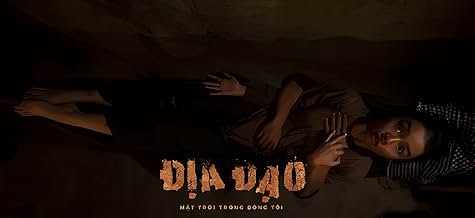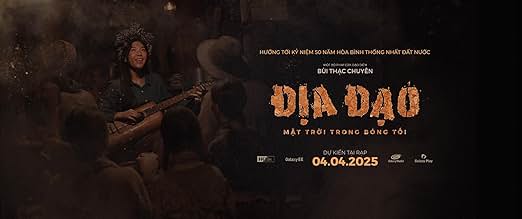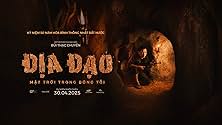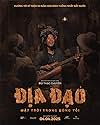Ajouter une intrigue dans votre langueIn 1967, as the Vietnam War raged, a Vietnamese revolutionary guerrilla team became the U.S. military's top target - charged with safeguarding a secret group of intelligence agents at all co... Tout lireIn 1967, as the Vietnam War raged, a Vietnamese revolutionary guerrilla team became the U.S. military's top target - charged with safeguarding a secret group of intelligence agents at all costs.In 1967, as the Vietnam War raged, a Vietnamese revolutionary guerrilla team became the U.S. military's top target - charged with safeguarding a secret group of intelligence agents at all costs.
- Réalisation
- Scénario
- Casting principal
Avis à la une
I'm a Vietnamese born in peacetime-even my parents' generation didn't really witness the full consequences of our long resistance wars. I only knew about the wars against the French and the Americans through school lessons and bits of information on social media.
But 'Tunnel' really hit me. It completely shifted my perspective on war. The film powerfully depicts the toughness and resilience of the people in the Cu Chi tunnels in particular, and the Vietnamese people of that time in general; as well a. The 250 kilometers of dark, suffocating tunnels beneath the ground were where they lived, planned, and prepared to fight back against American forces with tanks and advanced weapons. That's how we've come to have the peaceful life we live today, and I'm deeply grateful for that.
The use of period-specific language was a nice touch. There's one intimate scene in the film that was very tastefully done and felt true to the character's humanity. And it doesn't over-glorify the Vietnamese side, nor does it vilify the Americans-U. S. soldiers are portrayed as tough and skilled fighters.
The color grading in the film is beautiful. I'm not entirely sure how others might view this film-I studied at an art school and have some understanding of cinema, but with any film, different people will connect with it in different ways. Personally, I found it deeply impressive-both in terms of the director's craft and the stories told in and around the film.
But 'Tunnel' really hit me. It completely shifted my perspective on war. The film powerfully depicts the toughness and resilience of the people in the Cu Chi tunnels in particular, and the Vietnamese people of that time in general; as well a. The 250 kilometers of dark, suffocating tunnels beneath the ground were where they lived, planned, and prepared to fight back against American forces with tanks and advanced weapons. That's how we've come to have the peaceful life we live today, and I'm deeply grateful for that.
The use of period-specific language was a nice touch. There's one intimate scene in the film that was very tastefully done and felt true to the character's humanity. And it doesn't over-glorify the Vietnamese side, nor does it vilify the Americans-U. S. soldiers are portrayed as tough and skilled fighters.
The color grading in the film is beautiful. I'm not entirely sure how others might view this film-I studied at an art school and have some understanding of cinema, but with any film, different people will connect with it in different ways. Personally, I found it deeply impressive-both in terms of the director's craft and the stories told in and around the film.
The concept is terrific-a war movie crafted with a setting and perspective that, at times, evoke the atmosphere of a horror film.
To bring this vision to life, Bui Thac Chuyen shows remarkable restraint, opting for a minimalist yet impactful approach-from the acting and sparse dialogue to the subtle use of patriotic symbolism. It's rare to see a Vietnamese director place such trust in the audience's ability to interpret and feel.
Unfortunately, the editing undermines much of that intention. Some scenes are difficult to follow, while others verge on unintentionally comedic due to awkward cut timing. Most frustrating of all, the dialogue is often hard to hear. As a native Vietnamese speaker, I found it absurd that I had to rely on English subtitles just to understand what the characters were saying.
That said, it's still refreshing to see a Vietnamese film with a clear, confident identity-one that doesn't depend on rapid-fire dialogues and petty arguments to move the plot forward.
To bring this vision to life, Bui Thac Chuyen shows remarkable restraint, opting for a minimalist yet impactful approach-from the acting and sparse dialogue to the subtle use of patriotic symbolism. It's rare to see a Vietnamese director place such trust in the audience's ability to interpret and feel.
Unfortunately, the editing undermines much of that intention. Some scenes are difficult to follow, while others verge on unintentionally comedic due to awkward cut timing. Most frustrating of all, the dialogue is often hard to hear. As a native Vietnamese speaker, I found it absurd that I had to rely on English subtitles just to understand what the characters were saying.
That said, it's still refreshing to see a Vietnamese film with a clear, confident identity-one that doesn't depend on rapid-fire dialogues and petty arguments to move the plot forward.
A short and succinct summary of one of many battles conducted during the VN war. Dark and realistic, director Chuyen takes artistic liberties yet still fully immerse audience in VN in the 1900s. The cast was a fresh and enthusiastic ensemble which brought a much needed breath of fresh air to the acting quality. The story, although rough around the edges, paints a lovely picture of the patriotism and humanity of the characters (more like children) involved in the preservation of indepence. The ending was artisticly beautiful, albeit I believe it leaves audience with more emotions than actual answers, conclusive endings to the stories told.
Politically, the film echoes the tone of past propaganda cinema-drawing a clear, almost cartoonish line between the heroic, morally flawless Vietnamese fighters and the evil, inhuman enemy. Such reductionist storytelling undermines the very complexity of history, turning real human suffering into scripted spectacle. Modern audiences, especially younger generations who have grown up with access to global perspectives, no longer respond to one-sided narratives. They seek stories with depth, vulnerability, and moral ambiguity-something dia dao completely lacks.
More importantly, the film weaponizes patriotism in a heavy-handed way. Rather than trusting viewers to feel national pride through authentic, human storytelling, it forces them into admiration with loud speeches, dramatic music, and hollow symbols. In doing so, it disrespects the intelligence of its audience and, paradoxically, cheapens the very ideals it sets out to honor.
More importantly, the film weaponizes patriotism in a heavy-handed way. Rather than trusting viewers to feel national pride through authentic, human storytelling, it forces them into admiration with loud speeches, dramatic music, and hollow symbols. In doing so, it disrespects the intelligence of its audience and, paradoxically, cheapens the very ideals it sets out to honor.
Tunnel: Sun in the Dark is a Vietnamese historical war drama that plunges audiences into the heart of the Vietnam War's most turbulent years. Directed by Bui Thac Chuyen, this film is both a personal and national tribute-a vivid re-creation of the life and sacrifice of the guerrilla fighters who once hid in the labyrinthine tunnels of Cu Chi during 1967.
A Glimpse Into History Set against the backdrop of the Vietnam War's deadliest phase, the film follows a small but resolute guerrilla unit of 21 fighters. Under the steady command of Bay Theo (portrayed by Thai Hoa), the group is tasked with protecting a covert strategic intelligence team from the relentless assault of American forces. The narrative, drawn from real historical events, captures the stark realities of combat and the unsung heroism of soldiers fighting not for glory but for survival and the future of their nation.
Storytelling and Direction Bui Thac Chuyen's directorial approach is both innovative and rooted in authenticity. Instead of opting for a linear, conventional war story, he employs interwoven narratives that mirror the chaotic and fragmented nature of wartime existence. This technique not only maintains a constant sense of tension and mystery but also forces viewers to actively engage with the unfolding events-much like the soldiers themselves, who had to piece together survival strategies under dire circumstances.
The film deliberately eschews overt, bombastic heroism. Instead, it emphasizes the day-to-day struggles, the bittersweet moments of camaraderie, and the subtle, raw expressions of human vulnerability. In doing so, the director transforms the tunnel itself into a character-a silent witness to the myriad sacrifices and quiet acts of defiance that defined this chapter in Vietnam's history.
Production Design and Cinematography One of the film's standout achievements is its meticulous production design. To accurately recreate the claustrophobic and dangerous environment of the Cu Chi tunnels, the production team built a 250-meter-long tunnel model, capturing the oppressive darkness and narrow passageways that the real-life guerrilla fighters navigated daily. The cinematography further amplifies this sense of entrapment and urgency. With skillful use of light and shadow, the camera work draws viewers into the subterranean world where every footstep carries the weight of uncertainty and impending danger.
Stellar Performances The film's cast delivers remarkably authentic performances that elevate the entire production. Thai Hoa, reprising his role as Bay Theo, imbues the character with a palpable sense of duty and internal conflict. His portrayal is both commanding and deeply human, reflecting the heavy burdens of leadership amidst chaos.
Quang Tuan's dedication to his role as Tu Dap is evident-his physical transformation, achieved through rigorous weight loss and intense physical training, underscores the extremes to which the actors went to mirror the hardships of the era. Meanwhile, Ho Thu Anh and Diem Hang Lamoon bring emotional depth and nuance to their respective characters, capturing the delicate balance between fierce determination and personal vulnerability. Their performances add layers to the narrative, making the film's portrayal of war not just about physical battles, but about the internal battles of hope, love, and loss.
Themes and Emotional Impact At its core, Tunnel: Sun in the Dark is more than a war film-it's a meditation on sacrifice, resilience, and the price of freedom. The film's stark realism forces audiences to confront the brutality of war: the constant fear, the physical and emotional toll, and the profound sense of isolation experienced by those who fight from the shadows. Yet, amidst this darkness, the film also reveals moments of tender humanity-brief flashes of laughter, quiet gestures of solidarity, and even the fragile stirrings of romance. These interludes serve as poignant reminders that even in the bleakest of times, the human spirit continues to seek connection and meaning.
Conclusion Tunnel: Sun in the Dark stands out as a significant achievement in Vietnamese cinema. With its painstaking attention to historical detail, innovative narrative structure, and deeply affecting performances, the film offers a window into a past marked by sacrifice and unwavering resolve. It challenges the audience to reflect on the true cost of freedom and the enduring legacy of those who fought-not for fame or fortune, but for the very soul of their nation.
For anyone interested in a film that is as intellectually engaging as it is emotionally stirring, Tunnel: Sun in the Dark is a must-watch. It is a cinematic journey that not only redefines the war genre but also reaffirms the indomitable spirit of Vietnam's people.
A Glimpse Into History Set against the backdrop of the Vietnam War's deadliest phase, the film follows a small but resolute guerrilla unit of 21 fighters. Under the steady command of Bay Theo (portrayed by Thai Hoa), the group is tasked with protecting a covert strategic intelligence team from the relentless assault of American forces. The narrative, drawn from real historical events, captures the stark realities of combat and the unsung heroism of soldiers fighting not for glory but for survival and the future of their nation.
Storytelling and Direction Bui Thac Chuyen's directorial approach is both innovative and rooted in authenticity. Instead of opting for a linear, conventional war story, he employs interwoven narratives that mirror the chaotic and fragmented nature of wartime existence. This technique not only maintains a constant sense of tension and mystery but also forces viewers to actively engage with the unfolding events-much like the soldiers themselves, who had to piece together survival strategies under dire circumstances.
The film deliberately eschews overt, bombastic heroism. Instead, it emphasizes the day-to-day struggles, the bittersweet moments of camaraderie, and the subtle, raw expressions of human vulnerability. In doing so, the director transforms the tunnel itself into a character-a silent witness to the myriad sacrifices and quiet acts of defiance that defined this chapter in Vietnam's history.
Production Design and Cinematography One of the film's standout achievements is its meticulous production design. To accurately recreate the claustrophobic and dangerous environment of the Cu Chi tunnels, the production team built a 250-meter-long tunnel model, capturing the oppressive darkness and narrow passageways that the real-life guerrilla fighters navigated daily. The cinematography further amplifies this sense of entrapment and urgency. With skillful use of light and shadow, the camera work draws viewers into the subterranean world where every footstep carries the weight of uncertainty and impending danger.
Stellar Performances The film's cast delivers remarkably authentic performances that elevate the entire production. Thai Hoa, reprising his role as Bay Theo, imbues the character with a palpable sense of duty and internal conflict. His portrayal is both commanding and deeply human, reflecting the heavy burdens of leadership amidst chaos.
Quang Tuan's dedication to his role as Tu Dap is evident-his physical transformation, achieved through rigorous weight loss and intense physical training, underscores the extremes to which the actors went to mirror the hardships of the era. Meanwhile, Ho Thu Anh and Diem Hang Lamoon bring emotional depth and nuance to their respective characters, capturing the delicate balance between fierce determination and personal vulnerability. Their performances add layers to the narrative, making the film's portrayal of war not just about physical battles, but about the internal battles of hope, love, and loss.
Themes and Emotional Impact At its core, Tunnel: Sun in the Dark is more than a war film-it's a meditation on sacrifice, resilience, and the price of freedom. The film's stark realism forces audiences to confront the brutality of war: the constant fear, the physical and emotional toll, and the profound sense of isolation experienced by those who fight from the shadows. Yet, amidst this darkness, the film also reveals moments of tender humanity-brief flashes of laughter, quiet gestures of solidarity, and even the fragile stirrings of romance. These interludes serve as poignant reminders that even in the bleakest of times, the human spirit continues to seek connection and meaning.
Conclusion Tunnel: Sun in the Dark stands out as a significant achievement in Vietnamese cinema. With its painstaking attention to historical detail, innovative narrative structure, and deeply affecting performances, the film offers a window into a past marked by sacrifice and unwavering resolve. It challenges the audience to reflect on the true cost of freedom and the enduring legacy of those who fought-not for fame or fortune, but for the very soul of their nation.
For anyone interested in a film that is as intellectually engaging as it is emotionally stirring, Tunnel: Sun in the Dark is a must-watch. It is a cinematic journey that not only redefines the war genre but also reaffirms the indomitable spirit of Vietnam's people.
Le saviez-vous
- Versions alternativesAn alternate version, titled the Director's Cut, was released on April 30, 2025. This cut is 3 minutes shorter than the original theatrical version.
Meilleurs choix
Connectez-vous pour évaluer et suivre la liste de favoris afin de recevoir des recommandations personnalisées
Détails
Box-office
- Budget
- 2 240 000 $US (estimé)
- Montant brut mondial
- 6 641 870 $US
- Durée2 heures 8 minutes
- Couleur
- Mixage
- Rapport de forme
- 2.76 : 1
Contribuer à cette page
Suggérer une modification ou ajouter du contenu manquant



















